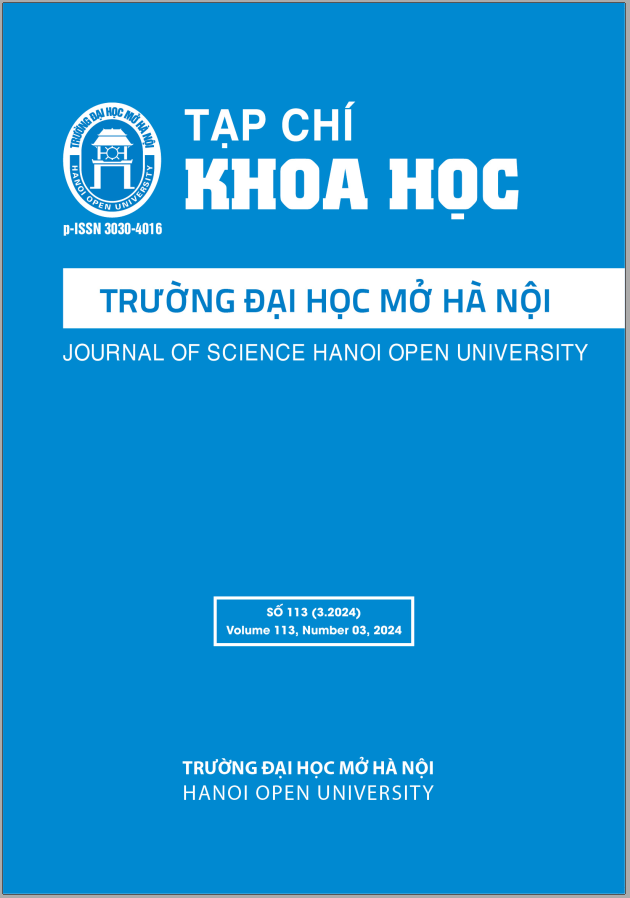FACTORS INFLUENCING THE INTERACTION OF THIRD-YEAR ENGLISH MAJORS IN SPEAKING CLASSES AT HANOI OPEN UNIVERSITY
DOI:
https://doi.org/10.59266/houjs.2024.377Từ khóa:
classroom interaction, students’ interaction, speaking classes, participation in class activities, interpersonal interactionTóm tắt
This study investigates external and internal factors affecting students’ interaction in English-speaking classes to develop effective strategies to improve their interaction. The study was conducted among sixteen classes at the Faculty of English at Hanoi Open University, with 86 students in total. Questionnaires and interviews were employed as data collection instruments for the study. The results showed that there are still a large number of ‘passive’ students who are not willing to speak and participate in class activities for different reasons, both coming from external and internal ones. These factors mainly include “self-confidence”, “motivation, and interest”, “prior relationships”, “classroom environment,” “lecturers’ teaching styles”, and “technological devices”. Accordingly, different techniques and teaching methods were recommended to promote students’ interaction during speaking lessons, including “pair work,” “asking-answering questions,” “debate sessions or discussion,” and “interactive multimedia learning.” The study results are expected to help both students and lecturers identify influential factors and explore more effective strategies or teaching methods to enhance students’ participation in English-speaking classes.
Tài liệu tham khảo
[1]. Allwright, R. L. (1984). The importance of interaction in classroom language learning. Applied linguistics, 5(2), 156-171.
[2]. Berge, Z. L. (1999). Interaction in post-secondary web-based learning. Educational technology, 39(1), 5-11.
[3]. Dulock, H. L. (1993). Research design: Descriptive research. Journal of Pediatric Oncology Nursing, 10(4), 154-157.
[4]. Ellis, R. (1999). Learning a second language through interaction (Vol. 17). John Benjamins Publishing.
[5]. Garrison, D. R. (1993). Quality and theory in distance education: Theoretical considerations. In D. Keegan (Ed.), Theoretical principles of distance education. New York: Routledge
[6]. Gilbert, L., & Moore, D. R. (1998). Building interactivity into Web courses: Tools for social and instructional interaction. Educational Technology, 38(3), 29-35.
[7]. Guo, T., Gong, Y., Shi, S., & Luan, Z. (2018, November). Reasons that Affect the Interaction Among Students in Virtual Learning Environment. In IOP Conference Series: Materials Science and Engineering (Vol. 439, No. 3, p. 032051). IOP Publishing.
[8]. Gurtman, M. B. (2009). Exploring personality with the interpersonal circumplex. Social and personality psychology compass, 3(4), 601-619.
[9]. Jacobs, G. M., Renandya, W. A., Power, M., Jacobs, G. M., Renandya, W. A., & Power, M. (2016). Student–student interaction. Simple, powerful strategies for student-centered learning, 11-18.
[10]. Johnson, D. W. (1981). Student-student interaction: The neglected variable in education. Educational researcher, 10(1), 5-10.
[11]. Kiesler, D. J. (1996). From communications to interpersonal theory: A personal odyssey. Journal of Personality Assessment, 66(2), 267-282.
[12]. Maloof, V.M., & Boyd, M. (2000). Student-proposed intertextual links to facilitate students. Second and foreign language learning through classroom interaction, 163-182.
[13]. Pennings, H. J., Brekelmans, M., Sadler, P., Claessens, L. C., van der Want, A. C., & van Tartwijk, J. (2018). Interpersonal adaptation in teacher-student interaction. Learning and Instruction, 55, 41-57.
[14]. Sadler, P., & Woody, E. (2003). Is who you are who you’re talking to? Interpersonal style and complementarity in mixed-sex interactions. Journal of Personality and Social Psychology, 84, 80-96.
[15]. Sadler, P., Ethier, N., & Woody, E. (2010). Interpersonal complementarity. In L. M. Horowitz, & S. Strack (Eds.), Handbook of interpersonal psychology: Theory, research, assessment, and therapeutic interventions (pp. 123-142). NY: Wiley.
[16]. Simpson, R. J., & Galbo, J. J. (1986). Interaction and learning: Theorizing on the art of teaching. Interchange, 17(4), 37–51. https://doi.org/10.1007/BF01807015
[17]. Smyth, R. (2005). Broadband Videoconferencing as a Tool for Learner-Centered Distance Learning in Higher Education. British Journal of Educational Technology 36, 5: 805-820.
[18]. Tsui, A. B. (1998). The ‘Unobservable’ in classroom interaction. The Language Teacher.
[19]. Van Manen, M. (1997). Phenomenological pedagogy and the question of meaning. Phenomenology & education discourse, 41-68.
[20]. Weller, H. G. (1988). Interactivity in microcomputer-based instruction: Its essential components and how it can be enhanced. Educational Technology, 28(2), 23-27.
